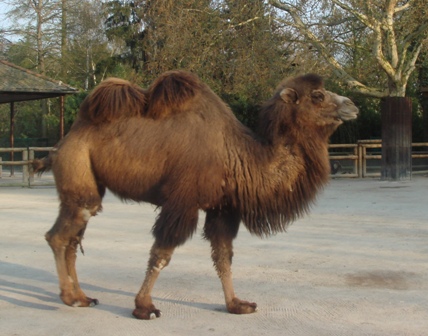
Bactrian camel (Camelus bactrianus)
Phylum —chordata
Class — mammalia
Order — artiodactyla
Family — camelidae
Genus – camelus
Appearance
The Bactrian camel is the largest mammal in its native range and is the largest living camel. Shoulder height is from 180 to 230 cm (5.9 to 7.5 ft), head-and-body length is 225–350 cm (7.38–11.48 ft), and the tail length is 35–55 cm (14–22 in). At the top of the humps, the average height is 213 cm (6.99 ft). Body mass can range from 300 to 1,000 kg (660 to 2,200 lb), with males often being much larger and heavier than females. Its long, wooly coat varies in colour from dark brown to sandy beige. A mane and beard of long hair occurs on the neck and throat, with hairs measuring up to 25 cm (9.8 in) long.
The shaggy winter coat is shed extremely rapidly, with huge sections peeling off at once, appearing as if sloppily shorn. The two humps on the back are composed of fat (not water as is sometimes thought). The face is typical of a camelid, being long and somewhat triangular, with a split upper lip. The long eyelashes, along with the sealable nostrils, help to keep out dust in the frequent sandstorms which occur in their natural range. The two broad toes on each foot have undivided soles and are able to spread widely as an adaptation to walking on sand. The feet are very tough, as befits an animal of extreme environments.
Habitat
The Bactrian camel is a native of the steppes in eastern Asia. In the wild its range is limited to remote parts of the Gobi Desert of Mongolia and the Taklamakan Desert of China. A small number still roam in southwest Kazakhstan in the Mangystau Province, and in India in the Kashmir Valley.
Behavior
Wild Bactrians are active in the daytime, looking for food, and at night they sleep in an open space. Camels that have been domesticated travel across the desert in caravans. The wild camels are highly migratory, herds traveling huge distances in search of water and food sources. In the autumn, herds of up to 100 animals may gather at the start of the rutting season, typically in the more mountainous areas where there is greater availability of water. At other times, family groups consist of 6 to 30 animals with a dominant male as the leader.
Diet
Bactrian camels are herbivores and can eat plants that are prickly, dry, salty, and/or bitter, but they like any kind of vegetation. If other food is not available, they may eat bones, other animals' skin, and different kinds of flesh. They may eat sandals, ropes and even tents in more extreme conditions.
Reproduction
Bactrian camels are polygynous animals. Dominant males will defend groups of females against other males during the breeding season, which occurs in the fall. The males during this time tend to be violent and may spit, bite or try to sit on other males. Gestation lasts for 13 months, with most calves born in March and April. One calf is usually produced but occasionally there are two. Females can give birth every other year. The calf is precocial, with the ability to stand as soon as it is born and to walk within just a few hours. The young calf remains for between three and five years with its mother, until it is sexually mature, at 3-4 years of age for females and 5-6 years old for males.
In captivity
The lifespan of Bactrian camels is up to 50 years, often from 20 years to 40 years in captivity.
In nomadic or semi-nomadic farming, camels are kept all year round on free grazing.At a settled life style in places with severe winter-they are kept without a leash in sheds with a paddock yard, in southern areas — often under canopies. The camel barn must be dry, with regularly changing bedding (made of the remnants of hay, weeds, reeds). In winter, in case of severe frost, camels are sometimes covered with felt blankets.
Camels are herbivores, so like all herbivores they are given grass, hay, a mixture of cut vegetables, branches, and oats. It is forbidden to feed the animal with other products.
 Russian
Russian
 English
English


















